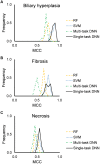Deep Neural Network Models for Predicting Chemically Induced Liver Toxicity Endpoints From Transcriptomic Responses
- PMID: 30804783
- PMCID: PMC6370634
- DOI: 10.3389/fphar.2019.00042
Deep Neural Network Models for Predicting Chemically Induced Liver Toxicity Endpoints From Transcriptomic Responses
Abstract
Improving the accuracy of toxicity prediction models for liver injuries is a key element in evaluating the safety of drugs and chemicals. Mechanism-based information derived from expression (transcriptomic) data, in combination with machine-learning methods, promises to improve the accuracy and robustness of current toxicity prediction models. Deep neural networks (DNNs) have the advantage of automatically assembling the relevant features from a large number of input features. This makes them especially suitable for modeling transcriptomic data, which typically contain thousands of features. Here, we gaged gene- and pathway-level feature selection schemes using single- and multi-task DNN approaches in predicting chemically induced liver injuries (biliary hyperplasia, fibrosis, and necrosis) from whole-genome DNA microarray data. The single-task DNN models showed high predictive accuracy and endpoint specificity, with Matthews correlation coefficients for the three endpoints on 10-fold cross validation ranging from 0.56 to 0.89, with an average of 0.74 in the best feature sets. The DNN models outperformed Random Forest models in cross validation and showed better performance than Support Vector Machine models when tested in the external validation datasets. In the cross validation studies, the effect of the feature selection scheme was negligible among the studied feature sets. Further evaluation of the models on their ability to predict the injury phenotype per se for non-chemically induced injuries revealed the robust performance of the DNN models across these additional external testing datasets. Thus, the DNN models learned features specific to the injury phenotype contained in the gene expression data.
Keywords: artificial neural network; biliary hyperplasia; classification model; liver fibrosis; liver necrosis; machine leaning; toxicity prediction.
Figures




Similar articles
-
Predicting drug-target interaction network using deep learning model.Comput Biol Chem. 2019 Jun;80:90-101. doi: 10.1016/j.compbiolchem.2019.03.016. Epub 2019 Mar 25. Comput Biol Chem. 2019. PMID: 30939415
-
Deep Learning on High-Throughput Transcriptomics to Predict Drug-Induced Liver Injury.Front Bioeng Biotechnol. 2020 Nov 27;8:562677. doi: 10.3389/fbioe.2020.562677. eCollection 2020. Front Bioeng Biotechnol. 2020. PMID: 33330410 Free PMC article.
-
Prediction of Compound Profiling Matrices, Part II: Relative Performance of Multitask Deep Learning and Random Forest Classification on the Basis of Varying Amounts of Training Data.ACS Omega. 2018 Sep 30;3(9):12033-12040. doi: 10.1021/acsomega.8b01682. Epub 2018 Sep 27. ACS Omega. 2018. PMID: 30320286 Free PMC article.
-
Deep learning for predicting toxicity of chemicals: a mini review.J Environ Sci Health C Environ Carcinog Ecotoxicol Rev. 2018;36(4):252-271. doi: 10.1080/10590501.2018.1537563. Epub 2019 Mar 1. J Environ Sci Health C Environ Carcinog Ecotoxicol Rev. 2018. PMID: 30821199 Review.
-
Illuminating the Black Box: Interpreting Deep Neural Network Models for Psychiatric Research.Front Psychiatry. 2020 Oct 29;11:551299. doi: 10.3389/fpsyt.2020.551299. eCollection 2020. Front Psychiatry. 2020. PMID: 33192663 Free PMC article. Review.
Cited by
-
Leveraging high-throughput screening data, deep neural networks, and conditional generative adversarial networks to advance predictive toxicology.PLoS Comput Biol. 2021 Jul 2;17(7):e1009135. doi: 10.1371/journal.pcbi.1009135. eCollection 2021 Jul. PLoS Comput Biol. 2021. PMID: 34214078 Free PMC article.
-
Detecting Novel Ototoxins and Potentiation of Ototoxicity by Disease Settings.Front Neurol. 2021 Aug 17;12:725566. doi: 10.3389/fneur.2021.725566. eCollection 2021. Front Neurol. 2021. PMID: 34489859 Free PMC article. Review.
-
Computational models for predicting liver toxicity in the deep learning era.Front Toxicol. 2024 Jan 19;5:1340860. doi: 10.3389/ftox.2023.1340860. eCollection 2023. Front Toxicol. 2024. PMID: 38312894 Free PMC article. Review.
-
Use of deep learning methods to translate drug-induced gene expression changes from rat to human primary hepatocytes.PLoS One. 2020 Aug 11;15(8):e0236392. doi: 10.1371/journal.pone.0236392. eCollection 2020. PLoS One. 2020. PMID: 32780735 Free PMC article.
-
In silico toxicology: From structure-activity relationships towards deep learning and adverse outcome pathways.Wiley Interdiscip Rev Comput Mol Sci. 2020 Jul-Aug;10(4):e1475. doi: 10.1002/wcms.1475. Epub 2020 Mar 31. Wiley Interdiscip Rev Comput Mol Sci. 2020. PMID: 35866138 Free PMC article. Review.
References
-
- Breiman L. (2001). Random forests. Mach. Learn. 45 5–32. 10.1023/a:1010933404324 - DOI
LinkOut - more resources
Full Text Sources

